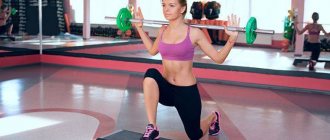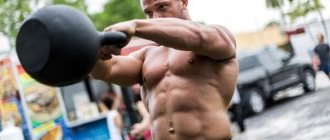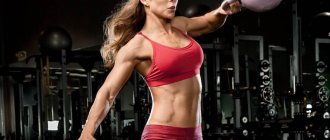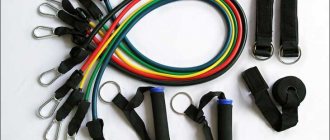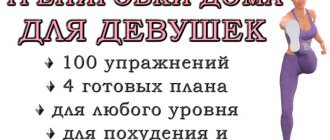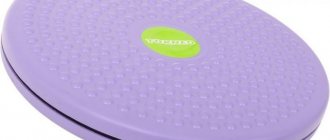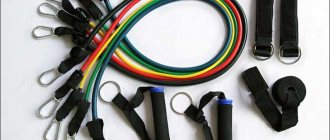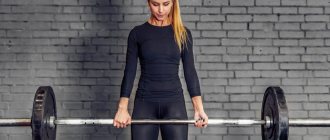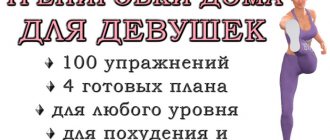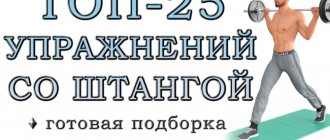May 29, 2022 Admin Home page » Tips and tricks
Learn how to properly train with a kettlebell. Detailed list of exercises. Training program. Advice from trainers. How to choose the right weights.
All exercises with a kettlebell are an excellent way to improve strength, while the duration of the exercise can partially replace cardio training. The workouts have their differences from the more familiar sports equipment, which are barbells and dumbbells.
Below are described in detail the pros and cons of training, many nuances of implementation and advice from trainers. The article turned out to be long, but rich; after reading it, many will learn the answers to previously open questions.
Why do you need a kettlebell?
Training with a kettlebell engages all muscles, increases strength, improves endurance and feline agility. In addition, if you look at many weightlifters, during long training they are all wet from hard work, because the load involves burning a large number of calories, which helps improve the relief.
The starting date of kettlebell lifting is considered to be 1885 in Russia. An interesting fact is that in translation from Spanish “pesa rusa” is translated as “weights” or “Russian weight”.
Currently, kettlebells have become widespread in all countries of the world, they are popular in crossfit, many athletes use them to prepare for various competitions. In addition to this, exercises with weights at home are a good way to create an athletic body or maintain existing parameters.
Many have seen the film Thor, and so the main character Chris Hemsfort actively included weights in his training in preparation for filming.
Operating rules
There are the following rules for training with these manual exercise machines:
- You need to select the weight of the kettlebell correctly and not immediately take on the heaviest ones, thinking that you can handle them. In this case, unprepared muscles can become very sore and cannot withstand such a load.
- You need to choose your training location carefully. Of course, it's best to practice outside, because that's where you won't be afraid of dropping the weight on the floor and damaging something. But not everyone has this opportunity, so when working out at home or in the gym, you should always be careful not to damage yourself or the objects around you.
- You should not use mirrors, because they will constantly distract attention, which can lead to injury. There is no need to use gloves on your hands, since they will only reduce the pressure, which in turn will confuse and deceive the reaction of the muscles. The same applies to shoes with heels, which are the most dangerous.
- Do not exercise when you have no strength, health or mood, since training in this case will still not be effective. It is best to reschedule it for another day when you feel well.
- You need to schedule your training days and your goals that you want to achieve through training in advance. This way, you will have a certain plan of action and lines for which you need to lose excess weight, which will motivate you to take action.
- In the breaks between classes, you don’t need to sit still, otherwise you’ll just relax and by the second approach you won’t have the strength. It is best to do lighter exercise or just walk during this time.
- It is necessary for the body to recover between days of training. This means that during this period you need to get a good night’s sleep, avoid stress and anxiety, and do not drink alcohol. In addition, you should eat well so that you have the strength to train.
Features of training with kettlebells
Kettlebell training can be used by both men and the fairer sex; they are often used for the following areas:
⇒ crossfit;
⇒ HIIT (high-intensity interval training);
⇒ tabata;
⇒ cardio training;
⇒ various game sports competitions.
Do not confuse regular strength training with kettlebell lifting, because working with a kettlebell forces you to focus on movement technique, and not on muscle structure.
Kettlebell lifting is aimed at improving strength (strength, coordination, endurance, flexibility). There is an opportunity to actively train absolutely everywhere, the only downside will be to take such a weight with you.
For bodybuilding enthusiasts, the kettlebell is not the best way to increase muscle mass. Of course, it will help break through stagnation in muscle growth and increase strength, but it has minimal effect on the growth of muscle fibers.
Therefore, training is best suited for those who want to lose weight, get out of stagnation, achieve new results and the already known fact of increasing strength.
The benefits of training
What is good about this kind of training? Complexes with weights allow you to work out muscles not only in the gym, but also in the comfort of home for many. This is an undoubted and undeniable plus that immediately attracts attention. Moreover, not only men, but also women can enjoy training with kettlebells. This is exactly the kind of sports equipment that, with the right training program, will allow you to burn the hated fat mass or add muscle mass. It all depends on what the training itself will be aimed at. This could be high-intensity interval kettlebell training, CrossFit, cardio training, Tabata training or some kind of game sport.
What muscles are involved when training with a kettlebell?
The legs and back are included in the work to the maximum. In addition, the shoulders, abs, buttocks and arm muscles receive stress. Training with a kettlebell is good for general physical development, because many muscle groups are simultaneously involved in the work. Of course, you can use kettlebells as an isolated exercise, but their true purpose is to train the entire body in a comprehensive manner.
Those who are already familiar with weights are very familiar at first with the sensation of body soreness, because stabilizer muscles (core muscles) are actively involved in the work. It is worth remembering that with weak core muscles, the likelihood of back pain increases, and this is also the cause of stooping.
In order for the training to be as effective as possible, it is necessary at the beginning of training to learn how to proportionally distribute the load between the back and legs.
Most people often make the same mistake, involving their arms and back as much as possible, while using their legs minimally. This will not only reduce the effectiveness of training, but also increase the chance of injury. It is always worth remembering that the muscles of the legs and buttocks should give the starting impetus to lifting the weight, and not the lower back and arms.
How to perform kettlebell swings
There are several N. J. Meigh, J. W. L. Keogh, B. Schram & W. A. Hing. Kettlebell training in clinical practice: a scoping review / BMC Sports Science, Medicine and Rehabilitation of types of kettlebell swings that differ from each other in technical terms:
- Russian kettlebell swings are the most common option, which does not require long mastery or special physical training. In this design, the projectile rises only to the level of the chest (clavicles).
- The American Kettlebell Swing is a variation in which the kettlebell moves over a wider range and is raised above the head with extended arms. Most often this method can be found in CrossFit.
- One-arm kettlebell swing with a double squat - this variation is used in kettlebell lifting and is essentially one of the phases of the competitive kettlebell snatch movement.
If you are not going to compete in CrossFit or kettlebell lifting, choose Russian swings.
How to perform Russian kettlebell swings
Stand with your feet shoulder-width apart, place the weight in front of your toes at a distance of about 30 cm.
Bend your knees slightly and lean forward with your back straight. Grasp the handle of the kettlebell with an overhand grip, lowering your shoulders and shoulder blades to engage your lats.
Lift the bar off the floor, then, keeping your back straight, bend at the hip and swing the weight back between your legs. There is no need to do squats in this phase.
At the same time, the legs at the knees also bend, but only slightly. In the video below, BJ Gaddour from Men's Health shows the correct position during the backswing.
Next, sharply straighten up at the hip and knee joints, giving the weight acceleration. Do not strain your arms: the projectile should fly forward due to the extension of the hips. Imagine that your hands are two ropes to which a weight is attached.
When the projectile reaches the level of your collarbones, let it fall along the same trajectory and bring it back between your legs.
Make sure to maintain a neutral lower back position: do not slouch during the swing phase, but do not arch in the lower back either. Keep your neck in line with your back, do not lift your head to look forward when bending over.
Pay attention to your feet: they should stand firmly on the floor, without leaving it during any phase of the exercise.
If the handle of the kettlebell slips, use chalk to prevent the weight from falling out of your fingers during the swing.
How to do American Kettlebell Swings
The first phase of this exercise is the same as in the Russian version.
You bend at the hip with a neutral spine and slide the kettlebell between your legs. Then you straighten up, raising the projectile in front of your body with outstretched arms.
Only in the American swing is the kettlebell brought to a position above the head and only then lowered along the same trajectory.
Because you need to lift the kettlebell higher, this exercise will require a more powerful swing, which will increase the energy cost of the movement and make it more difficult.
Therefore, if you are doing well with the Russian version, before doing the American one, change the weight to a lighter one in order to get comfortable with the technique and not injure your shoulders.
How to do a one-arm kettlebell swing with a double squat
Stand with your feet shoulder-width apart and place the weight about 30 cm from your toes. Lean towards it with your back straight and grab the handle with one hand. Hold the second one freely at a distance from the body.
To avoid overloading your forearms, pay attention to your grip. Don't squeeze the kettlebell too hard. Instead, form a four-finger hook and slide the projectile onto it, then press your index finger with your thumb to form a lock.
Lift the kettlebell and swing back between your legs. When the projectile passes the line of your feet, straighten your limbs at the knees while maintaining the tilt of the body.
Then, with an additional squat, bring the weight forward, straightening the body, as well as the legs at the hip and knee joints. Squatting between the swing and releasing the projectile in front of you provides more inertia, so you can swing with one arm without working your shoulder muscles.
When the weight reaches shoulder level, allow it to fall along the same trajectory and at this time bend your legs at the hip and knee joints. At the extreme point of the swing, when the projectile is between your legs, straighten up again and start again.
What are the benefits of weights for losing weight and growing muscles?
Studies conducted in the USA have proven the fact that training with weights can burn about 20 kcal. in 1 minute, which in 1 hour will be 1200 kcal.! This effect is achieved due to the simultaneous activation of a large number of muscle fibers and the high pace of exercise.
This is why people who are obese are sometimes recommended to train with weights. The standard exercise is to perform the exercise with a 16 kg kettlebell, but there is a more gentle option of 8 kg.
In order for weight to begin to decrease, in addition to proper nutrition, you need to devote 20-45 minutes to exercise 2 to 4 times a week. The workouts already include cardio, so if you want to, you don’t need to set aside separate time for running.
As mentioned above, for muscle growth, kettlebells are not the best option; if the goal is to increase muscle mass, then dumbbells and a barbell are a more preferable option. It’s a good idea to use fitness rubber to warm up before training, which will prepare the body for a more serious load.
Let's summarize all the pros and cons of training from using this equipment:
Sequence of exercises [ edit | edit code ]
Be sure to start your workout with a warm-up. Kettlebell training is much harder and more intense than training with barbells and dumbbells, so you need to warm up your muscles, ligaments and tendons much more carefully.
It would be a good idea to spend a few minutes doing joint exercises, working on a treadmill or pedaling an exercise bike. This will significantly increase blood supply to all muscle groups and reduce muscle recovery time.
An intensive warm-up will allow you to train more often, and muscle growth will accelerate.
Each new exercise should be performed with light weight at first. There are several reasons for this:
Only a thoughtful approach to body development can bring quick and significant results.
Benefits of Kettlebell Training
♦ range and mobility of movements improves, without prolonged stretching and static load;
♦ tendons and ligaments are strengthened;
♦ develops speed, endurance, coordination and agility;
♦ the muscle corset is strengthened, especially the muscles surrounding the spine;
♦ a large number of muscles are involved in the work, providing a general strengthening effect on the body;
♦ the ability to create an athletic body with an elastic structure with a minimum percentage of fat;
♦ the weight will last a long time, unless of course you throw it on the floor;
♦ training of the respiratory and cardiovascular system.
Week schedule
In order for the training process to be more effective, it is recommended to create an individual schedule for performing specific exercises on certain days of the week.
A set of exercises with a kettlebell
The table below shows the schedule of classes using kettlebells:
| Day of the week | Organization of the training process |
| Monday | Monday is the first day of the training program. At this stage of training with a weight, it is recommended to perform the following exercises: “Rotation of the weight around the axis of your body”, “Pressing a sports equipment”, as well as its “Rotation over your head”. The average training duration is 40-50 minutes. |
| Tuesday | On Tuesday, it is necessary to provide the body with complete rest and recovery. On this day, the girl should exclude physical activity. You should pay special attention to the quality of your diet, eating vegetables, fresh fruits, meat, and dairy products. |
| Wednesday | On Wednesday, it is recommended to start performing exercises in the form of “Kettlebell Throw”, “Push Up” and “Deadlift”. It is better to start the training process with those physical activities that are easiest. This will allow you to maintain a reserve of strength before the most difficult exercise. |
| Thursday | On Thursday you need to rest and recuperate. Increasing physical strength, strengthening ligaments and tendons is possible only with high-quality nutrition and rational distribution of loads. On this day, you are allowed to do only a light morning warm-up to warm up the tissues. |
| Friday | On Friday, you need to perform exercises in the form of “Pulling with a weight behind the back”, “Pulling a sports equipment to the chest”, as well as “Squats”. The average duration of the training process should not exceed 1 hour. Otherwise, the effect of physical fatigue may develop. |
| Saturday | Saturday should be devoted to rest, proper nutrition and restoration of the body. On this day, physical activity is contraindicated. |
| Sunday | Sunday is a day of active cardiological training of moderate intensity. After waking up from sleep, it is recommended to do a warm-up for all parts of the musculoskeletal system, and then go for a walk, hike over rough terrain, ride a bike, jog in the fresh air or swim in the pool. |
The training program begins again on Monday. After completing each set of exercises, it is recommended to replenish lost calories only with biologically healthy foods.
A girl’s diet should include the following foods:
- fruits and vegetables;
- greenery;
- meat;
- chicken eggs;
- ocean fish and other seafood;
- milk;
- cereal porridge;
- cottage cheese;
- hard cheese;
- kefir.
High-quality nutrition is the key to getting a positive result as quickly as possible, as well as maintaining a healthy body . If during training there is acute or aching pain in the muscles, joints or ligaments, you must stop further exercise and be examined by a traumatologist.
Disadvantages of Kettlebell Training
♦ not the best option for increasing muscle mass;
♦ increased risk of injury if performed incorrectly, especially at the initial stage of training. In addition, you need to get used to the fact that when you throw the weight up, it noticeably hits the outside of the wrist;
♦ if the spine and the muscles that support it are weak, the heavy weight of the kettlebell can cause injury;
♦ a high-quality projectile made from a good alloy is quite expensive;
♦ you should not train if you have problems with the heart and blood vessels, during the recovery period after surgery, or if you have problems with the musculoskeletal system.
Important point
You should know that such exercises are quite traumatic, so you need to do them very carefully. Also, they have the following contraindications:
- Pregnancy.
- Heart diseases.
- Disorders of the musculoskeletal system.
- Periods after fractures and surgical interventions, when not yet a year has passed since (it is better not to risk your health and fully recover before such stress).
- Haemorrhoids.
- Rachiocampsis.
A set of exercises with a kettlebell
The proposed set of exercises with a kettlebell is aimed at training the abs, lower and upper body and the entire body as a whole. To develop strength and muscle strengthening, you need to perform 15 repetitions; if the goal is to burn as many calories as possible, then the number of repetitions increases to 20.
There are 2 important rules to remember:
♦ if the goal is to train the whole body in a day, then all the proposed exercises can be performed comprehensively in 1 approach;
♦ if the goal is to specifically train a separate part of the body, each exercise is performed in 3-4 approaches. Or perform the exercises sequentially, for example, for the upper body 3-4 circles.
Lower body workout
Abs workout
Upper body workout
Full body workout
How to include these exercises in your workout?
Since these are quite intense and vigorous exercises, including them all in one workout is not a good idea. You can gradually incorporate them into your workouts over the course of a week . For example, do one exercise in a full-body workout , include another in a HIIT workout , and leave the rest for lower-body strength training . It is also important to consider the distribution of exercises within one workout. This means that you include the most difficult exercises, such as squats and lunges, at the very beginning, when you have the most energy.
If you work out at home and want to create your own workout plan, don't miss our article How to Create a Quality Home Workout Plan? And if you want to kill all those muscles with your home workout, you can take inspiration from our article on How to Make Your Home Workout More Intense Even Without Sports Equipment.
Before you start training, be sure to warm up thoroughly and prepare your body and mind for the upcoming stress. You can jump, dance to your favorite song, or do a few burpees. Then warm up the large joints of the whole body with circular movements , as you were taught in physical education lessons, and you can safely dive into the main part. You can do lower body workout twice a week . The number of reps is up to you, but always monitor how you feel so that your muscles are properly burned by the end of the set and you can train until your muscles are exhausted. Once you've completed the main part, allow yourself to cool down a bit and some light stretching in the form of a static stretch.
Workout example table - choose the weight yourself
| Exercise | Number of repetitions | Number of approaches | break between sets |
| Jumping with a kettlebell | 8–12 | 3–4 | 1–2 min. |
| Reverse lunges with kettlebell | 10–16 | 3–4 | 1–2 min. |
| Deadlift with kettlebell | 8–15 | 3–4 | 1–2 min. |
| Kettlebell Squats | 8–15 | 3–4 | 1–2 min. |
| Single leg deadlift with kettlebell | 8–12, one leg, then the other leg | 3–4 | 1–2 min. |
Helpful tips for effective training
♦ before performing exercises, always do a warm-up and cool-down to prepare all muscles for working with sports equipment;
♦ train with weights based on your capabilities, otherwise it’s easy to get injured. You shouldn’t grab 24 or 36 kg without preparation. looking at experienced athletes, remember that they also started with 8 kg;
♦ if you have experience as a weightlifter, then for men the optimal weight is 16-24 kg, and for women within 8-16 kg;
♦ when performing all exercises, avoid stooping, keep your back straight. When squats are performed, the pelvis goes back so that at the bottom of the squat, the knees do not go beyond parallel with the toes;
♦ perform exercises with a neutral grip of the hands; ideally, there should be no bends at all. To help, it is possible to use special clamps that hold the wrists in the desired position, which will help keep the joints healthy;
♦ all movements are performed with complete control; there is no need to jerk the weight until your joints crack. It may seem at first glance that experienced weight lifters are simply swinging the apparatus, but in fact they do everything strictly according to technique;
♦ if it is possible to train with 2 weights, then they must be of the same weight. This will allow you to load the left and right sides evenly, avoid developmental imbalances and reduce the likelihood of injury due to possible misalignment of the weight being lifted.
Muscles used in the one-arm kettlebell press
With this press, you work almost your entire body, even while sitting. Here are the muscles you can activate when performing any of the one-arm kettlebell press variations, from top to bottom.
- Deltoid muscles (front and side)
- Rotator cuff
- Upper chest
- Upper back (plates and trapezius)
- Triceps
- Forearm (wrist flexors and extensors)
- Serratus anterior muscle
- Core muscles
- Buttocks
- Hamstrings (mostly in the seated press)
